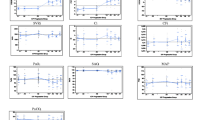Abstract
Background
Plateau waves are common in traumatic brain injury. They constitute abrupt increases of intracranial pressure (ICP) above 40 mmHg associated with a decrease in cerebral perfusion pressure (CPP). The aim of this study was to describe plateau waves characteristics with multimodal brain monitoring in head injured patients admitted in neurocritical care.
Methods
Prospective observational study in 18 multiple trauma patients with head injury admitted to Neurocritical Care Unit of Hospital Sao Joao in Porto. Multimodal systemic and brain monitoring of primary variables [heart rate, arterial blood pressure, ICP, CPP, pulse amplitude, end tidal CO2, brain temperature, brain tissue oxygenation pressure, cerebral oximetry (CO) with transcutaneous near-infrared spectroscopy and cerebral blood flow (CBF)] and secondary variables related to cerebral compensatory reserve and cerebrovascular reactivity were supported by dedicated software ICM+ (www.neurosurg.cam.ac.uk/icmplus). The compiled data were analyzed in patients who developed plateau waves.
Results
In this study we identified 59 plateau waves that occurred in 44 % of the patients (8/18). During plateau waves CBF, cerebrovascular resistance, CO, and brain tissue oxygenation decreased. The duration and magnitude of plateau waves were greater in patients with working cerebrovascular reactivity. After the end of plateau wave, a hyperemic response was recorded in 64 % of cases with increase in CBF and brain oxygenation. The magnitude of hyperemia was associated with better autoregulation status and low oxygenation levels at baseline.
Conclusions
Multimodal brain monitoring facilitates identification and understanding of intrinsic vascular brain phenomenon, such as plateau waves, and may help the adequate management of acute head injury at bed side.





Similar content being viewed by others
References
Janny P. La Pression Intracranienne Chez l’Homme [Thèse médecine]. Paris: Thèse médecine; 1950.
Lundberg N. Continuous recording and control of ventricular fluid pressure in neurosurgical practice. Acta Psychiatr Neurol Scand. 1960;36:1–193.
Rosner MJ, Becker DP. Origin and evolution of plateau waves. Experimental observations and a theoretical model. J Neurosurg. 1984;60:312–24.
Avezaat CJ, van Eijndhoven JH, Wyper DJ. Cerebrospinal fluid pulse pressure and intracranial volume pressure relationships. J Neurol Neurosurg Psychiatry. 1979;42:687–700.
Castellani G, Zweifel C, Kim DJ, et al. Plateau waves in head injured patients requiring neurocritical care. Neurocrit Care. 2009;11:143–50.
Hayashi M, Kobayashi H, Kawano H, Yamamoto S, Maeda T. Cerebral blood flow and ICP patterns in patients with communicating hydrocephalus after aneurysm rupture. J Neurosurg. 1984;61:30–6.
Hayashi M, Handa Y, Kobayashi H, Kawano H, Ishii H, Hirose S. Plateau-wave phenomenon (I). Correlation between the appearance of plateau waves and CSF circulation in patients with intracranial hypertension. Brain. 1991;114(Pt 6):2681–91.
Matsuda M, Yoneda S, Handa H, Gotoh H. Cerebral hemodynamic changes during plateau waves in brain-tumor patients. J Neurosurg. 1979;50:483–8.
Renier D, Sainte-Rose C, Marchac D, Hirsch JF. Intracranial pressure in craniostenosis. J Neurosurg. 1982;57:370–7.
Radolovich DK, Czosnyka M, Timofeev I, et al. Transient changes in brain tissue oxygen in response to modifications of cerebral perfusion pressure: an observational study. Anesth Analg. 2010;110:165–73.
Ursino M, Di Giammarco P. A mathematical model of the relationship between cerebral blood volume and intracranial pressure changes: the generation of plateau waves. Ann Biomed Eng. 1991;19:15–42.
Aries MJ, Czosnyka M, Budohoski KP, et al. Continuous determination of optimal cerebral perfusion pressure in traumatic brain injury. Crit Care Med. 2012;40:2456–63.
Brain Trauma Foundation, American Association of Neurological Surgeons, Congress of Neurological Surgeons, et al. Guidelines for the management of severe traumatic brain injury. IX. Cerebral perfusion thresholds. J Neurotrauma. 2007;24(Suppl 1):59–64.
Smielewski P, Czosnyka M, Steiner L, Belestri M, Piechnik S, Pickard JD. ICM+: software for on-line analysis of bedside monitoring data after severe head trauma. Acta Neurochir Suppl. 2005;95:43–9.
Czosnyka M, Smielewski P, Kirkpatrick P, Laing RJ, Menon D, Pickard JD. Continuous assessment of the cerebral vasomotor reactivity in head injury. Neurosurgery. 1997;41:11–7 discussion 7–9.
Aries MJ, Czosnyka M, Budohoski KP, et al. Continuous monitoring of cerebrovascular reactivity using pulse waveform of intracranial pressure. Neurocrit Care. 2012;17:67–76.
Brady KM, Lee JK, Kibler KK, et al. Continuous time-domain analysis of cerebrovascular autoregulation using near-infrared spectroscopy. Stroke. 2007;38:2818–25.
Jaeger M, Schuhmann MU, Soehle M, Meixensberger J. Continuous assessment of cerebrovascular autoregulation after traumatic brain injury using brain tissue oxygen pressure reactivity. Crit Care Med. 2006;34:1783–8.
Citerio G, Andrews PJ. Intracranial pressure. Part two: clinical applications and technology. Intensive Care Med. 2004;30:1882–5.
Balestreri M, Czosnyka M, Hutchinson P, et al. Impact of intracranial pressure and cerebral perfusion pressure on severe disability and mortality after head injury. Neurocrit Care. 2006;4:8–13.
Budohoski KP, Zweifel C, Kasprowicz M, et al. What comes first? The dynamics of cerebral oxygenation and blood flow in response to changes in arterial pressure and intracranial pressure after head injury. Br J Anaesth. 2012;108:89–99.
Czosnyka M, Smielewski P, Piechnik S, et al. Hemodynamic characterization of intracranial pressure plateau waves in head-injury patients. J Neurosurg. 1999;91:11–9.
Varsos GV, Richards H, Kasprowicz M, et al. Critical closing pressure determined with a model of cerebrovascular impedance. J Cereb Blood Flow Metab. 2013;33:235–43.
Brady KM, Lee JK, Kibler KK, et al. The lower limit of cerebral blood flow autoregulation is increased with elevated intracranial pressure. Anesth Analg. 2009;108:1278–83.
Conflict of interest
The software for brain monitoring ICM+ (www.neurosurg.cam.ac.uk/imcplus) is licensed by the University of Cambridge (Cambridge Enterprise). Peter Smielewski and Marek Czosnyka have financial interests in a part of the licensing fee. All other authors declare that they have no conflict of interest.
Author information
Authors and Affiliations
Corresponding author
Rights and permissions
About this article
Cite this article
Dias, C., Maia, I., Cerejo, A. et al. Pressures, Flow, and Brain Oxygenation During Plateau Waves of Intracranial Pressure. Neurocrit Care 21, 124–132 (2014). https://doi.org/10.1007/s12028-013-9918-y
Published:
Issue Date:
DOI: https://doi.org/10.1007/s12028-013-9918-y




